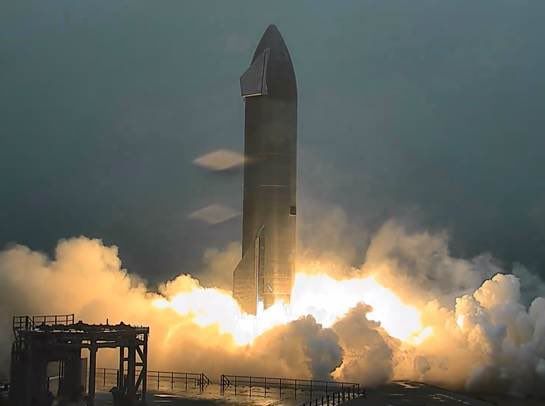SpaceX’s Starship SN9 prototype fires engines again to prep for test flight

SpaceX’s latest Starship prototype may now be cleared for takeoff.
The Starship SN9 vehicle performed its fifth static fire test Friday morning (Jan. 22), briefly lighting its three Raptor engines at 9:59 a.m. EST (1459 GMT) while remaining firmly on the ground at SpaceX’s South Texas facility, near the Gulf Coast village of Boca Chica.
Static fires are common preflight checkouts for SpaceX rockets, and SN9 might now have checked enough boxes to launch on a high-altitude test mission in the coming days — perhaps as early as Monday (Jan. 25).
Starship and Super Heavy: SpaceX’s Mars-colonizing vehicles in images
STATIC FIRE! Starship SN9 fires up her three Raptors. Very smooth morning pad flow to ignition. Looks and sounded very good. Let’s hope the data was good to approve launch next week.SN9 Status:https://t.co/Q0QbkThFh6➡️https://t.co/KLFof9P5Ts pic.twitter.com/fs7KK78WYbJanuary 22, 2021
SN9’s flight is expected to resemble that of its predecessor, the three-engine SN8 vehicle, which soared about 7.8 miles (12.5 kilometers) above Boca Chica on Dec. 9. SN8 did everything that was asked of it that day except stick the landing; the stainless-steel craft came down a bit too fast and exploded when it hit its designated landing area.
SpaceX is developing Starship to carry people and cargo to the moon, Mars and other cosmic destinations. The transportation system consists of two elements, both of which will be fully and rapidly reusable: the 165-foot-tall (50 meters) Starship spacecraft and a huge booster known as Super Heavy.
Both will be powered by the next-gen Raptor. The final version of Starship will have six Raptors, and Super Heavy will sport about 30 of the engines, SpaceX founder and CEO Elon Musk has said. (Super Heavy will be needed to launch Starship off Earth, but the spacecraft will be able to get itself off both the moon and Mars.)
SpaceX is moving fast with Starship, as it tends to do with its projects. Musk has said that he expects Starship to begin flying people to Mars by 2026, and that this epic milestone could even occur in 2024 “if we get lucky.” (Mars missions work on roughly two-year cycles; Earth and Mars align properly for interplanetary missions every 26 months.)
SN9 previously performed one static fire on Jan. 6 and three in quick succession on Jan. 13. After the Jan. 13 tests, SpaceX swapped out two of the vehicle’s three engines, which Musk said needed slight repairs.
The prototype also appeared to attempt a static fire on Thursday (Jan. 21), but that try was so brief that it seems to have been aborted.
Mike Wall is the author of “Out There” (Grand Central Publishing, 2018; illustrated by Karl Tate), a book about the search for alien life. Follow him on Twitter @michaeldwall. Follow us on Twitter @Spacedotcom or Facebook.
